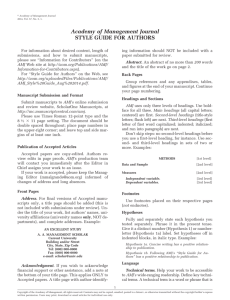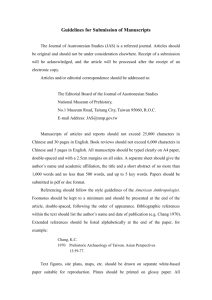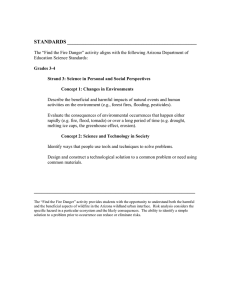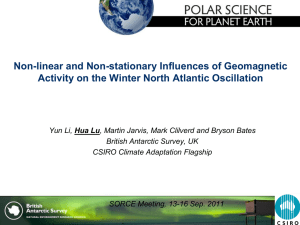Antecedent Precipitation Trumps Drought in Causing Southeast Arizona Wildfires
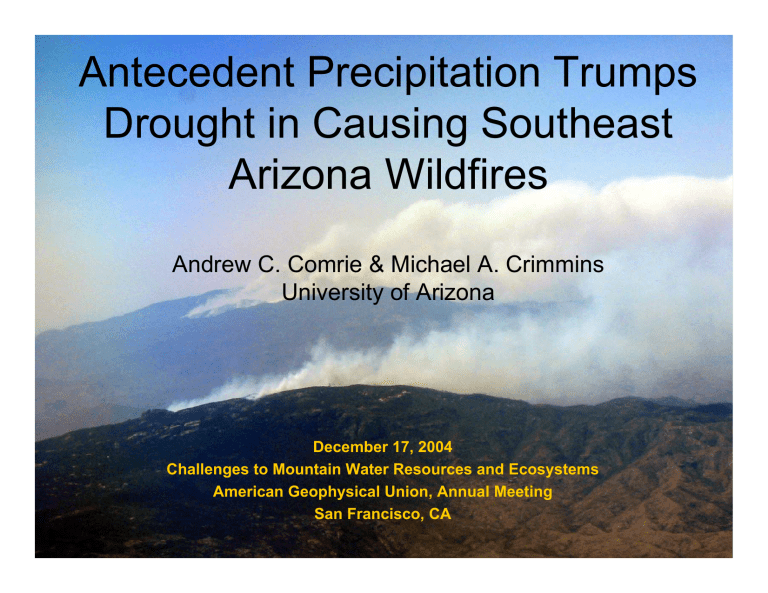
Antecedent Precipitation Trumps
Drought in Causing Southeast
Arizona Wildfires
Andrew C. Comrie & Michael A. Crimmins
University of Arizona
December 17, 2004
Challenges to Mountain Water Resources and Ecosystems
American Geophysical Union, Annual Meeting
San Francisco, CA
Research Objectives
• Identify relationships between antecedent climate and wildfire statistics at a seasonal resolution
– Diagnose importance of warm/cool season fine fuels
• Develop predictive models based on antecedent climate conditions at critical lags
• Identify mechanistic links between climate variability, ecosystem dynamics and wildfire across southeast
Arizona
• Bottom line, given that AMJ fire season is always hot and dry:
– Role of drought v. wet periods for SE AZ wildfire?
Arizona CD7
Methods
• Identify critical variables/lags for current & antecedent climate-fuel relationships
– Correlation analyses between lagged climate variables and seasonal wildfire data (aggregated
April-May-June; total acres burned & total number of fires)
– Climate variables screened by significance of correlations and principal components analysis
– Regression modeling based on screened variables
• Wildfire data grouped into ‘high elevation’ and
‘low-elevation’ subsets
Wildfire Data
• Multi-agency wildfire data referenced by lat-lon coordinates and merged with digital elevation model
(~10% of events with no lat/lon reference)
• Fire events split into high elevation and low elevation datasets to separate fine vs. heavy fuel fire-climate relationships
– 1350m (4400’), high:48% / low:52%
– 1500m (4900’), 27% / 73%
– 1700m (5500’), 16% / 84%
• Breakpoints guided by Whittaker and Niering 1965
Elevation Gradients
1700 m
1500 m
1350 m
From: Whittaker, R.H. and Niering, W.A., 1965. Vegetation of the Santa Catalina Mountains,
Arizona: A Gradient Analysis of the South Slope. Ecology, 46(4): 429-452.
Arizona CD7
Reanalysis Grid
Point
Climate Data
Synoptic Scale Forcing
NCEP Variables
700zw = 700mb zonal wind
700mw = 700mb meridional wind
700om = 700mb omega
700rh = 700mb relative humidity
700sh = 700mb specific humidity
300gh = 300mb geopotential height
700gh = 700mb geopotential height
850gh = 850mb geopotential height
Surface Environmental Conditions
Arizona Climate Div. #7
Temp_anom = temperature anomaly
PHDI = Palmer Hydrological Drought Index
PMDI = Palmer Meteorological Drought Index
Z_index = Palmer Z-index
PPT_anom = precipitation anomaly
PDSI = Palmer Drought Severity Index
Surface Variable Subset
Arizona Climate Div. #7
Temp_anom = temperature anomaly
Z_index = Palmer Z-index
PPT_anom = precipitation anomaly
PDSI = Palmer Drought Severity Index
Screened Variables
•Significant Correlations (>95%) at any lag
•Subjected to PCA to reduce collinearity
•Combinations of lagged variables systematically regressed with wildfire data
0.2
0.0
-0.2
-0.4
-0.6
-0.8
-1.0
1.0
0.8
0.6
0.4
1.0
0.8
0.6
0.4
0.2
0.0
-0.2
-0.4
-0.6
-0.8
-1.0
Results Example: Upper Elevation (>1500m) TNF
Z-Index PDSI
1.0
0.8
0.6
0.4
0.2
0.0
-0.2
-0.4
-0.6
-0.8
-1.0
Seasons
CD7 Precipitation Anomaly
Seasons
CD7 Temperature Anomaly
0.2
0.0
-0.2
-0.4
-0.6
-0.8
-1.0
1.0
0.8
0.6
0.4
Seasons Seasons
April-May-June Total Upper Elevation Wildfires in AZ Climate Division #7: 1973-2001
35
30
25
20
15
Model
1 (Constant)
Unstandardized
Coefficients
B
.774
TANOM0
PANOM15
7.897E-02
.298
Std. Error
.037
.018
.054
a.
Dependent Variable: H2_CT
Standardi zed
Coefficien ts
Beta
.478
.615
t
21.046
4.301
5.538
Sig.
.000
.000
.000
R 2 =0.750 R 2 cv
=0.705
•Wet at lag 15 (JAS-3)
•Fine fuel production still important
•Short-term drying now important
10
5
0
Dec-73 Dec-76 Dec-79 Dec-82 Dec-85
Observed
Dec-88
Date
Predicted (cv)
Dec-91
Predicted
Dec-94 Dec-97 Dec-00
Regression Model Summary
Model
Upper Elevation
Total Area
Burned (TAB)
Upper Elevation
Total Number of
Fires (TNF)
Lower Elevation
TAB
Lower Elevation
TNF
Variables
R 2 (crossvalidation)
Precip(JAS, –3 yrs),
PDSI(DJFM, –1 yr)
0.431 (0.354)
Temp(AMJ, 0 yr),
Precip(JAS, -3 yrs)
Temp(AMJ, 0 yr),
Precip(DJFM, 0 yr)
Temp(AMJ, 0 yr), Z-
Index(DJFM, 0 yr),
Precip(DJFM, -1 yr)
0.750 (0.705)
0.505 (0.397)
0.354 (0.285)
Santa Rita Experimental Range Monitoring Data and Southeast Arizona Climate/Wildfires
180
160
140
120
1982-1983 El Nino
100
80
0
-2
60
40
20 -8
0
D ec
-5
3
D ec
-5
5
D ec
-5
7
D ec
-5
9
D ec
-6
1
D ec
-6
3
E. Lehmanniana
D ec
-6
5
D ec
-6
7
D ec
-6
9
Native Spp
D ec
-7
1
D ec
-7
3
D ec
-7
5
D ec
-7
7
Low Elev. AMJ Fire Counts
D ec
-7
9
D ec
-8
1
D ec
-8
3
CD7 PDSI
D ec
-8
5
D ec
-8
7
D ec
-8
9
D ec
-9
1
D ec
-9
3
12 per. Mov. Avg. (CD7 PDSI)
D ec
-9
5
D ec
-9
7
D ec
-9
9
-10
-4
DRY
-6
8
6
WET
4
2
Conclusions
• Fuels-limited: antecedent precipitation controls total area burned
– climate important in regulating high & low elevation (fine) fuel production
• Surprisingly, no significant negative correlations between precipitation and seasonal wildfire statistics were found at any seasonal lag
– i.e., Drought conditions were not associated with higher area burned or a greater number of fires
• Larger low elevation fires were actually associated with wet antecedent conditions until just before the fire season
• Larger high elevation fires were associated with wet conditions during seasons up to 3 years before the fire season
• Caveats:
– Study decades were unusually wet; wildfire-drought relationships?
– Linear predictive models in a non-linear world?
– Climate can only explain part of overall wildfire variability
• Just published
– Crimmins, M. A. and Comrie, A.C., 2004: Interactions between antecedent climate and wildfire variability across southeast Arizona. International
Journal of Wildland Fire 13, 455-466.



